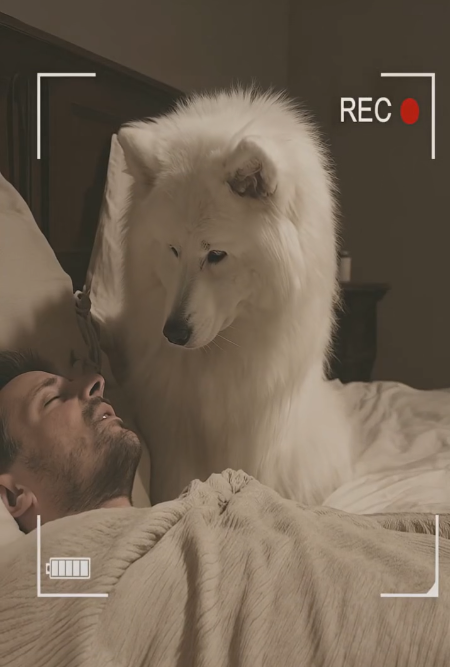When Emily and Mark finally chose to adopt a dog, they pictured the usual joys — long walks, warm snuggles, muddy paw prints, and a little more laughter filling their quiet home. They had been married for eight years, and after losing their cat the previous year, a new emptiness lingered. So, one Saturday morning, they drove to the nearby animal shelter, promising themselves they’d welcome home a soul who needed love as much as they did.
The shelter was alive with barks, whines, and wagging tails. Every kennel told a story — abandonment, neglect, or simply bad luck. Yet among the clamor, one dog sat quietly in the corner of her cage — a large white shepherd mix with calm, intelligent eyes that followed them attentively.
“She’s beautiful,” Emily whispered.
The shelter volunteer smiled. “That’s Daisy. She’s one of the sweetest dogs we’ve ever had. Gentle, trained, and trouble-free. We’ve all been wondering when she’d find the family meant for her.”
The decision was immediate. Within hours, Daisy was curled up on a blanket in the back seat, her tail gently thumping as they drove home.
At first, life with Daisy was everything they had hoped for. She was affectionate, polite, and seemed thankful for every small kindness — a head pat, a belly rub, a soft word. She followed Emily from room to room but never got in the way. At night, she settled quietly beside their bed, sighing softly before drifting off.
But within a week, something unusual began to happen.
It started subtly — a rustle in the dark, the sense of being watched. One night, Emily woke to find Daisy sitting at the foot of the bed, completely still, her gaze fixed on them. She didn’t growl or move — she just stared.
“Daisy?” Emily whispered.
The dog didn’t blink.
Mark stirred beside her. “What’s wrong?”
“She’s just… watching us.”
He squinted through the darkness. “Maybe she’s dreaming. Dogs do strange things at night.”
But it wasn’t a single incident. The next night, Daisy did it again. And again. Sometimes she sat so close that Emily could feel her breath on her arm. Occasionally, she placed a paw lightly on Mark’s chest, as if checking something.
By the week’s end, the couple felt uneasy.
“I don’t understand,” Mark muttered over morning coffee. “She’s perfect during the day, but at night she just… sits there like a statue.”
“Maybe she’s anxious,” Emily suggested. “Maybe she’s not used to sleeping near people.”
But that didn’t explain the intensity in Daisy’s eyes — or the soft whimpers she sometimes made while sitting tensely, ears alert, as if guarding against something unseen.
Then one night, it escalated.
Emily woke around 3 a.m. to see Daisy standing directly over Mark. Her paws pressed lightly against his chest, her nose nearly touching his face. Emily gasped and jumped up.
“Daisy! Off!”
The dog immediately stepped back, head lowered, tail tucked. She seemed ashamed — but not aggressive. Still, Emily’s heart raced.
The next morning, she told Mark they needed to figure out what was happening. “Maybe she’s ill,” she suggested. “Or perhaps there’s something wrong with her training.”
Mark agreed and that night set up a small camera on the dresser, aimed at the bed. “Just to see,” he said.
When they watched the footage the next morning, Emily’s stomach twisted.
Daisy barely slept. Each night she sat beside them, eyes open, following their movements. Whenever one shifted, she adjusted. Several times, she leaned in and placed a paw or her muzzle against Mark’s chest — then remained motionless.
“She’s not attacking,” Mark said quietly, “but… it’s unnerving.”
“I don’t like it,” Emily admitted. “It’s like she’s checking if we’re still breathing.”
That thought lingered.
By day’s end, Emily called the shelter, anxious.
“I’m so sorry,” she told the staff member. “Daisy is wonderful, but she’s acting strangely. At night she just stares at us. Sometimes she presses on us while we sleep. It feels… unsettling.”
The woman paused, then sighed softly.
“Ma’am, please don’t be upset with her. There’s something you should know about Daisy’s past.”
Emily’s grip tightened. “What do you mean?”
“Her previous owner was an elderly man,” the woman explained. “They were inseparable. Neighbors said Daisy followed him everywhere — even slept beside him each night. One morning, she wouldn’t stop barking. The neighbors went in and found he had passed away quietly in his sleep. Daisy stayed by his side the entire time.”
Silence followed.
The woman continued, her voice trembling slightly. “After he died, Daisy refused to sleep. She would sit up all night, watching his bed. Even in the shelter, she only napped briefly during the day. We thought a new family might help her move on. I guess… she’s still watching over the people she loves.”
By the time Emily hung up, tears blurred her vision. She turned to Mark, who was staring at Daisy sitting quietly by the window.
“She’s not guarding against us,” Emily whispered. “She’s protecting us. She’s afraid we’ll die in our sleep, like her previous owner.”
Mark’s expression softened. “She’s not keeping us awake. In her own way, she’s keeping us alive.”
That evening, they knelt beside Daisy, hugging her thick fur. She leaned into them, sighing deeply, as if finally understood.
From that night, they stopped trying to make her sleep. They moved her bed closer and left a nightlight on. When Emily saw Daisy’s eyes glinting in the dark, fear was replaced with gratitude.
Weeks later, Daisy relaxed. She still watched at night, but her gaze softened, her posture eased. Eventually, she began dozing beside them, one paw resting lightly on the blanket — as if to say, I’m here. You’re safe.
And perhaps, in her own way, she was right. Sometimes love doesn’t sleep. It only keeps watch — quietly, faithfully — through the night.
